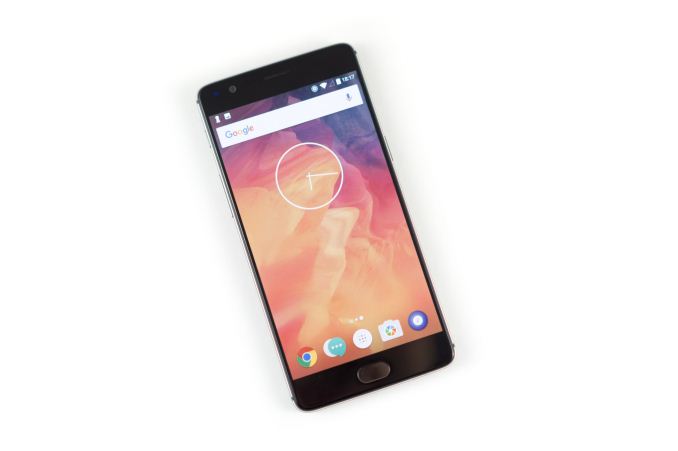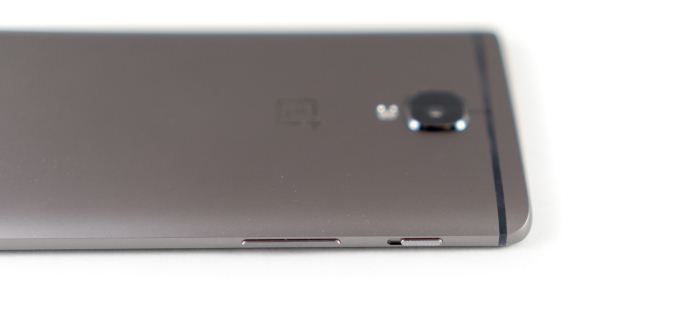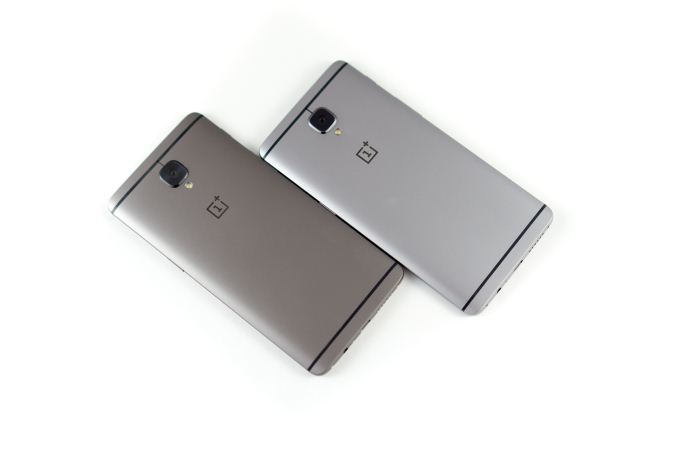The OnePlus 3T Review
by Brandon Chester on November 28, 2016 10:30 AM EST- Posted in
- Smartphones
- OnePlus
- OnePlus 3T

Back in June, OnePlus launched their new flagship smartphone, the OnePlus 3. I've had an interesting relationship with the OnePlus 3 due to certain decisions that were made regarding its display and some parts of the operating system before the phone initially launched. Since that time, OnePlus has made significant improvements to both of these aspects, and in my follow up piece I concluded that the OnePlus 3 should be considered by all smartphone buyers, even ones who were ready to pay $700 or $800 for a flagship phone from another company.
Earlier this month, OnePlus surprised a number of people in the Android community by launching a successor to the OnePlus 3. This move isn't in line with the yearly cadence that we've come to expect for their smartphones, which makes it all the more interesting. The name of this new phone is the OnePlus 3T, and based on that name one can already see that it represents an evolution of the OnePlus 3 rather than a revolutionary upgrade. As the OnePlus 3's successor, the OnePlus 3T simply serves to update certain aspects of the phone's hardware in order to take advantage of technology improvements that have been made available since the OnePlus 3 was originally developed and released.
This review focuses on the aspects of the OnePlus 3T that differ from its predecessor. Because of that, I recommend reading over my review of the OnePlus 3 if you're interested in other aspects of the phone like the camera quality. Before moving on, I've collected all the specifications for the OnePlus 3 and 3T in the chart below to make it clear which parts have changed and which have remained the same.
| OnePlus 3 | OnePlus 3T | ||
| SoC | Qualcomm Snapdragon 820 2 x 2.15GHz Kryo 2 x 1.6GHz Kryo 624MHz Adreno 530 |
Qualcomm Snapdragon 821 2 x 2.35GHz Kryo 2 x 1.6GHz Kryo 653MHz Adreno 530 |
|
| RAM | 6GB LPDDR4 | ||
| Display | 5.5" 1920 x 1080 PenTile AMOLED | ||
| Size / Mass | 152.7 x 74.7 x 7.35mm, 158g | ||
| Battery | 3000 mAh | 3400 mAh | |
| Rear Camera | 16MP 1.1 μm Sony IMX298, f/2.0, OIS | ||
| Front Camera | 8MP 1.4 μm Sony IMX179, f/2.0 |
16MP 1.0 µm Samsung S5K3P8, f/2.0 |
|
| Storage | 64GB UFS 2.0 | 64/128GB UFS 2.0 | |
| I/O | USB 2.0 Type-C connector, 3.5mm audio | ||
| Connectivity | 1x1 802.11a/b/g/n/ac + BT 4.2, USB-C, GPS/GNSS | ||
| Software | Android 6.0.1 OxygenOS 3.2.8 |
Android 6.0.1 OxygenOS 3.5.1 |
|
| Price | 64GB 399 USD |
64GB 439 USD 439 EUR 399 GBP 599 CAD |
128GB 479 USD 479 EUR 439 GBP 639 CAD |
For the most part, the OnePlus 3T is the same as the OnePlus 3. The size and mass are both the same, the display is the same, the rear-camera is the same, and the connectivity is the same. Internally OnePlus has made some changes to certain components. The most obvious change is the new SoC, with Snapdragon 820 being replaced with a faster Snapdragon 821 chip, while the RAM remains a healthy 6GB of LPDDR4. The battery capacity has also increased from 3000mAh to 3400mAh, which is a 13% increase without any change in the size or mass of the phone. The last major change is the new front-facing camera, which has moved from the 8MP 1.4µm Sony sensor on the OnePlus 3 to a 16MP 1.0µm Samsung sensor. In addition to the changes across all models, OnePlus has also introduced a 128GB SKU for users who need more storage. All of these changes also come at a higher price, with the 64GB model starting at $439, up from $399, and the 128GB model coming in at $479.
Design
As far as its design goes, the OnePlus 3T is mostly unchanged from its predecessor. I'm quite a fan of the OnePlus 3's design, so I don't feel that there was any need to change it significantly. The relatively thin body and the tapered back design make it far more usable with one hand than other 5.5" smartphones like the Pixel XL or the Moto G4. Being made from a single piece of aluminum, the chassis has none of the seams that the OnePlus One and OnePlus 2 had, and it feels incredibly solid in the hand. Unlike certain other vendors, OnePlus has also taken the time to actually align the various ports and buttons on the sides of the chassis instead of placing them wherever is convenient without any regard for aesthetics or usability.
Beyond the purely physical aspects of the design, I think OnePlus's design decisions regarding the placement of controls also makes the phone easier to use than competing devices. Having been using the OnePlus 3 since launch, I can say with certainty that OnePlus is on the right side of history by putting the volume rocker on the left side of the phone along with a physical switch for toggling notification settings. I also really appreciate having capacitive navigation buttons instead of wasting space on the display with on-screen buttons sitting above a bottom bezel that could easily fit physical ones. Putting the fingerprint scanner on the front of the phone as part of the home button also makes it simple to turn on and unlock the phone, even if it's sitting on a table.
The only aspect of the design that has changed from the OnePlus 3 is the color of the phone. The OnePlus 3 was originally available in a standard silver aluminum finish and later came in a gold finish, while the OnePlus 3T comes in a gunmetal grey finish and a gold finish from the start. The gold finish is only available in a 64GB capacity, while the gunmetal has both a 64GB and a 128GB version. For this review the 128GB gunmetal model was sampled, and I think it's a nice look for the phone. It's certainly not as dark as Apple's black iPhone 7 finish, but it's visibly darker than the OnePlus 3's aluminum and helps to distinguish between the two. I wouldn't have minded if OnePlus had also kept the standard silver finish available, as I think it looked rather nice as well, but I don't think the gunmetal is such a dramatic change in color that users will be bothered by silver being unavailable.












104 Comments
View All Comments
leexgx - Wednesday, January 18, 2017 - link
i just wish they keep most of the buttons near the top left and right side of the phone (some phones have the buttons to low so can use them in phone holder as it presses them)leexgx - Wednesday, January 18, 2017 - link
""can't use phone holder when are all on one side (power button right side, volume on left side is the preferable way, might not be ideal for left handed people but this is how they are norm setup)Pino - Monday, November 28, 2016 - link
ZTE Axon 7 for $ 349 on cyber Monday, with a free Bluetooth beats phone is a much better deal.JoeyJoJo123 - Monday, November 28, 2016 - link
I prefer having the ability to load the most common and popular open-source Android-based OS, Cyanogenmod. Cyanogenmod continues to issue updates to my (apparently ancient, despite only being 2 years old and still very functional) Nexus 4, which Google no longer provides updates for.ZTE Axon 7 has no Cyanogenmod support, and like many other Android phones, it will cease to have manufacturer support (planned obsolescence) after a year, if you're lucky.
I'm looking into a Oneplus 3T now, as Google no longer provides affordable Nexus phones, but mostly because my current Nexus 4 has a degraded battery life over 2 years of charge cycles. Despite lowering the brightness, barely using it, and blocking many applications, my Nexus 4 only tends to last me 12 hours of very light use, and sometimes it fails to last the work day, from when I remove the phone from the charger in the morning, by the time I get back home to charge it again. The upgraded 3400 mAh battery on the OnePlus 3T is a solid selling point, as I'm looking for better longevity of battery life 2 ~ 3 years down the line.
negusp - Monday, November 28, 2016 - link
The Axon 7 has a CM13 port, and everything seems to work so far.For the price the Axon is unbeatable.
And the Nexus 4 always had sh*t battery life. No way around it. Replacing the battery isn't too difficult either.
JoeyJoJo123 - Monday, November 28, 2016 - link
I'll have to concede, there does appear to be a port, but apparently you have to get it directly from XDA forums, and it's an unofficial port; it's not listed on the CyanogenMod website at all.http://forum.xda-developers.com/axon-7/development...
The following are the only official ZTE Cyanogenmod builds listed on Cyanogenmod's site:
https://download.cyanogenmod.org/
ZTE
Blade (blade)
Nubia Z9 Max (nx510j)
Skate (skate)
V9 (v9)
Meanwhile OnePlus's section includes every major phone they've released thus far, save for the 3T which was just released (and sure to get official support in the coming weeks).
OnePlus
2 (oneplus2)
3 (oneplus3)
One (bacon)
X (onyx)
Given ZTE's poor support record on CyanogenMod, I hope that changes for the better in the future. It's the poot CyanogenMod support for manufacturers like Xiaomi, Honor, and Huawei (and now ZTE) that prevent me from buying into the platform. When I buy a phone, a buy something sensibly priced and I intend for it to last me longer than even typical 2 year upgrade plans.
negusp - Monday, November 28, 2016 - link
Your last point is the most important. People who value a Nexus-like phone should get an Axon 7. In that way, we drive demand for ports and releases of custom ROMs.The 3T also won't get very much support, and hasn't been received kindly by the dev community. One of the most notable was flar2 who has said he won't be porting his elementalx kernel to it.
FlyBri - Monday, November 28, 2016 - link
It has already changed for the better ZTE has already confirmed it is working with Cyanogen mod as we speak, and so the Axon 7 is getting official CyanogenMod support. So while the ROM isn't out yet, one will be coming. Looks like your concern about poor support from ZTE regarding Cyangenmod has been eliminated.pierrot - Tuesday, November 29, 2016 - link
CM support official or not is a huge feature. It even makes that cheapo Amazon Fire halfway usablerealbabilu - Tuesday, November 29, 2016 - link
I disagree. CM support or Rom continuity always needed. Software bug , and security hole always there. There are not plenty mobile phone that keep it run long enough to patch every bug, as far i owned and experiences, those one with cm support like oneplus, those one with iOS, and those one with miui rom for Xiaomi phones, that updated regularly.And one thing others is availability hardware spare part, especially the battery and the screen replacement as those are fast moving sparepart for mobilephones. It can be replaced by third party repairman. iPhone always have a big numbers spare part availability on market, Xiaomi phones also have a lot. Oneplus not so many, ZTE even little.